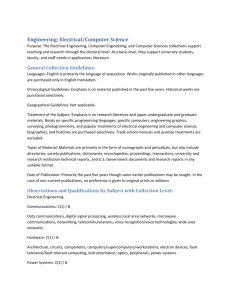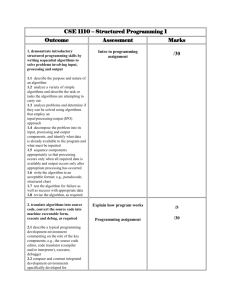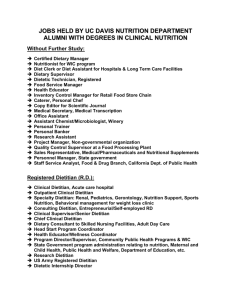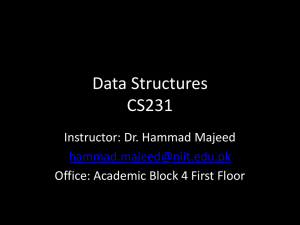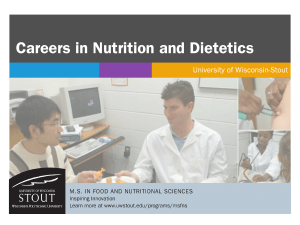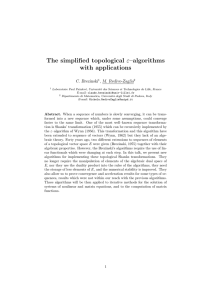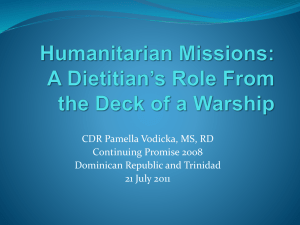1. Sheila A. Sorrentino. Assisting with Patient Care
advertisement
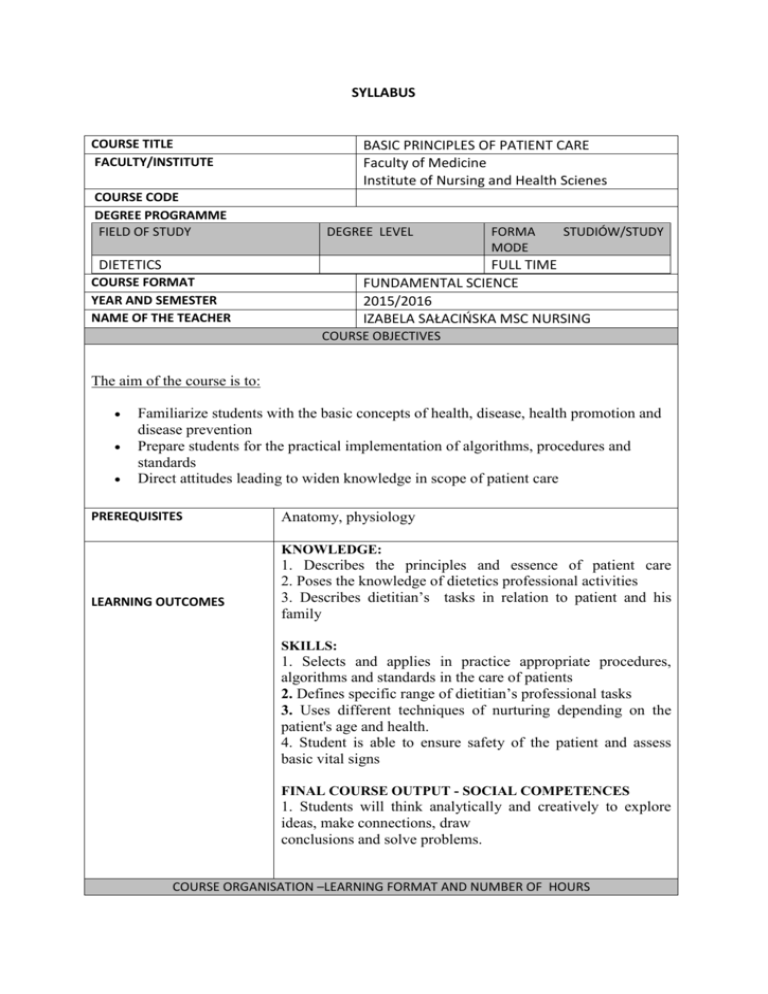
SYLLABUS COURSE TITLE FACULTY/INSTITUTE COURSE CODE DEGREE PROGRAMME FIELD OF STUDY BASIC PRINCIPLES OF PATIENT CARE Faculty of Medicine Institute of Nursing and Health Scienes DEGREE LEVEL DIETETICS FORMA MODE STUDIÓW/STUDY FULL TIME FUNDAMENTAL SCIENCE 2015/2016 IZABELA SAŁACIŃSKA MSC NURSING COURSE FORMAT YEAR AND SEMESTER NAME OF THE TEACHER COURSE OBJECTIVES The aim of the course is to: Familiarize students with the basic concepts of health, disease, health promotion and disease prevention Prepare students for the practical implementation of algorithms, procedures and standards Direct attitudes leading to widen knowledge in scope of patient care PREREQUISITES Anatomy, physiology KNOWLEDGE: LEARNING OUTCOMES 1. Describes the principles and essence of patient care 2. Poses the knowledge of dietetics professional activities 3. Describes dietitian’s tasks in relation to patient and his family SKILLS: 1. Selects and applies in practice appropriate procedures, algorithms and standards in the care of patients 2. Defines specific range of dietitian’s professional tasks 3. Uses different techniques of nurturing depending on the patient's age and health. 4. Student is able to ensure safety of the patient and assess basic vital signs FINAL COURSE OUTPUT - SOCIAL COMPETENCES 1. Students will think analytically and creatively to explore ideas, make connections, draw conclusions and solve problems. COURSE ORGANISATION –LEARNING FORMAT AND NUMBER OF HOURS Lectures - 5 hours Classes – 5 hours COURSE DESCRIPTION Subject: Basic of patient care is designed to familiarize students with algorithms, procedures and standards in reference to the diseased persons, taking actions in relation to patients in the measurement of vital signs, interviewing patient and different techniques nurturing depending on the age and health. Topics include the following: Health and disease. Basic concept. The scope and character of patient care. Iinterdisciplinary nature of dietitian’s activities. General rules of conduct, procedures and algorithms in the activities of a nutritionist to the patient. Measurement vital signs e.g. pulse, blood pressure, pain. Technique of washing hands. Interviewing with client / patient. Basic measures to ensure the safe and comfort of the patient. Nurturing patient’s depending on the health and age. METHODS OF INSTRUCTION REQUIREMENTS AND ASSESSMENTS GRADING SYSTEM TOTAL STUDENT WORKLOAD NEEDED TO ACHIEVE EXPECTED LEARNING OUTCOMES EXPRESSED IN TIME AND ECTS CREDIT POINTS LANGUAGE OF INSTRUCTION INTERNSHIP MATERIALS 1. Seminar with a multimedia presentation 2. Classes: Individual work, work with instruction, discussion, practice 1 Lecture: Passing the test 2 Classes: the implementation of the commissioned tasks, practice Grading scale F (2.0) – A (5.0) The final grade awarded at the end of the course is based on the following criteria: informed and active participation (50%), and final oral exam (50%). LECTURES AND CLASSES – 10 HOURS NUMBER OF CREDITS ECTS- 5 ENGLISH PRIMARY OR REQUIRED BOOKS/READINGS: 1. Gail Powell-Cope; Audrey L. Nelson; Emily S. Patterson. Patient Safety and Quality: An EvidenceBased Handbook for Nurses. 2. Robert J. Cipolle, Linda M. Strand, Peter C. MorleyImproving Patient Care: The Implementation of Change in Health Care SUPPLEMENTAL OR OPTIONAL BOOKS/READINGS: 1. Sheila A. Sorrentino. Assisting with Patient Care



